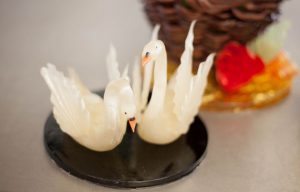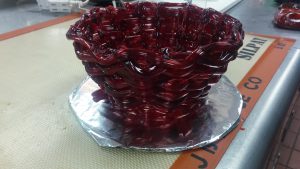
Image by: Blackburn College
Sugar is a centrical ingredient in the confectionary world. Being that I aspire to be a pastry chef, I am used to working with different types of sugar all the time. Each sugar can serve its own purpose in how it is utilized to create a particular dessert. There’s granulated cane sugar, turbinado sugar, light brown sugar, dark brown sugar, 10x sugar, pearl sugar, raw sugar, artificial sweeteners, and the list goes on. All of these sugar options are widely used to not only sweeten a dessert item but for its other properties as well. For instance when making sugar cookies, it is sometimes topped with granulated sugar and this is used to add crunch as well as more flavor to the cookies. If 10x sugar (also known as confectioner’s sugar) was used, it would essentially melt into the cookie causing it crackle.

Image by: Brianna Vasquez
Sugar is so valued and readily used in the confectionary world that it is almost always present as an ingredient in every dessert. One of the most amazing ways that sugar is utilized is to create sugar sculptures. The art of creating sugar sculptures consist of composing the most elaborate artistic masterpieces that are completely made from sugar and its fellow derivatives. In order to make these sculptures that sugar must be broken down and heated to a high temperature to allow it to be molded or shaped into the desired appearance. The recipe for making pulled sugar is granulated cane sugar which is cooked with water and glucose which can also be substituted for high fructose corn syrup. Then, an acidic agent is added to prevent crystallization from occurring when it reaches the hard crack stage which occurs at 300 degrees which is when coloring can be added right before it comes off the heat to allow the water from the coloring to reduce.

Image by: Brianna Vasquez
Hot sugar is divided into three separate categories which are pulled sugar, blown sugar, and cast sugar. Pulled sugar is when the sugar has been cooked into a liquid and poured usually over a Silpat which is a silicone rubber mat. The sugar is then pulled and folded repeatedly to incorporate air into the sugar which helps it to have a shine instead of being opaque. The sugar can then be molded into a variety of designs or shapes. Blown sugar is essentially pulled sugar that is blown into a shape with the help of a rubber pump. A portion of the pulled sugar is wrapped around the end of a rubber pump which is usually made out of wood or metal. Then, air is slowly pumped into the sugar to avoid it from cracking. Then, when the desired shape is achieved, the blown sugar is placed under a cool fan to allow it to harden to the shape. Finally, cast sugar is still a form of pulled sugar in which the hot sugar liquid is poured into molds this allows the pieces to harden into a desired shape that will be used as a base platform to hold you showpieces that have been blown or pulled.



